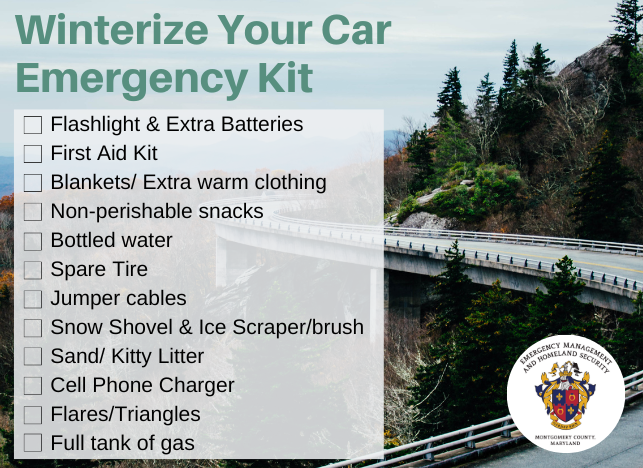Make a Kit
One of the most critical steps you can take to sustain yourself and your family during a disaster is to create an emergency kit before the disaster strikes.
An emergency kit contains items you might need during an emergency to sustain yourself and your family. These items will help you if you are asked to stay home for as many as three days.
However, a kit may also be useful incase you have to evacuate your home. If the items you need are in your emergency kit, you will not have to scramble at the last minute to gather important items. Download a printable checklist here.
Include the following items in your emergency kit:
Make a To-Go Kit
- Clothes and sturdy shoes that are appropriate for the weather (and extra blankets for winter)
- Cash in small bills
- Snacks and water
- Small first aid kit
- Hygiene Items (toothbrush, toothpaste, deodorant, feminine products, etc.)
- Eyeglasses
- Contacts and contact solution
- Communication devices/equipment
- Favorite personal or comfort items
- Cell Phone and chargers
- Flashlight and batteries
- Contact Information for your household members and members of your support network
- Important documents in a waterproof bag or container (Insurance cards, Medicaid/Medicare cards, photo IDs, proof of address, marriage certificate, birth certificates, copies of credit or debit cards.)
Gather Supplies to Shelter in Place
- Water (1 gallon of water per person per day for 3 days)
- Nonperishable food (3-day supply)
- Manual can opener
- Flashlight and extra batteries
- Radio and extra batteries
- First aid kit
- Whistle or bell to signal for help
- Paper and pencil/pen
- Cash in small bills
- Hygiene Items (toothbrush, toothpaste, deodorant, feminine products, etc.)
- Pair of heavy gloves
- Dust mask
- Important documents in a waterproof bag or container (Insurance cards, Medicaid/Medicare cards, photo IDs, proof of address, marriage certificate, birth certificates, copies of credit or debit cards.)
Additional Considerations
Consider adding any of the following to your emergency kit bases on your family's individuals needs:
- Prescription medications, at least a 3 day supply (as well as a list of what you take, why you take them, and their dosage)
- Non-prescription medications, such as pain relievers, anti-diarrhea medication, antacids, or laxatives
- Medical supplies (Oxygen, medication, scooter battery, hearing aid and batteries, mobility aids, glasses, etc.)
- Infant formula/babyfood, bottles, diapers, wipes
- Feminine products & other personal hygiene items
- Paper and pencil/pen
- Entertainment - books, toys, puzzles for children
- Supplies for service animals or pets (food, water, medicine, leash, collar, harness, veterinary info)
- Sleeping bag or blankets
- Kitty litter or sand for vehicles
- Jumper cables for vehicles
Maintaining Your Kit
After assembling your kit remember to maintain it so it’s ready when needed:
- Keep canned food in a cool, dry place
- Store boxed food in tightly closed plastic or metal containers
- Replace expired items as needed
- Re-think your needs every year and update your kit as your family’s needs change.
Kit Storage Locations

Since you do not know where you will be when an emergency occurs, prepare supplies for home, work and vehicles.
Work: Be prepared to shelter at work for at least 24 hours. Your work kit should include food, water and other necessities like medicines, as well as comfortable walking shoes, stored in a “grab and go” case.
Vehicle: In case you are ever stranded, it's a good idea to keep a kit of emergency supplies in your car.

